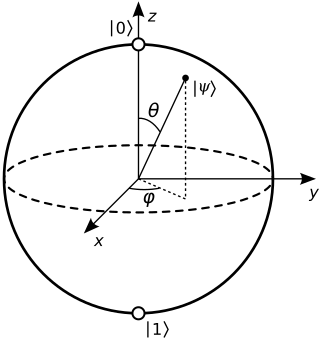Related Research Articles

Computing is any goal-oriented activity requiring, benefiting from, or creating computing machinery. It includes the study and experimentation of algorithmic processes, and the development of both hardware and software. Computing has scientific, engineering, mathematical, technological, and social aspects. Major computing disciplines include computer engineering, computer science, cybersecurity, data science, information systems, information technology, and software engineering.

A quantum computer is a computer that exploits quantum mechanical phenomena. On small scales, physical matter exhibits properties of both particles and waves, and quantum computing leverages this behavior using specialized hardware. Classical physics cannot explain the operation of these quantum devices, and a scalable quantum computer could perform some calculations exponentially faster than any modern "classical" computer. Theoretically a large-scale quantum computer could break some widely used encryption schemes and aid physicists in performing physical simulations; however, the current state of the art is largely experimental and impractical, with several obstacles to useful applications.

This is a timeline of quantum computing.
Quantum information science is a field that combines the principles of quantum mechanics with information theory to study the processing, analysis, and transmission of information. It covers both theoretical and experimental aspects of quantum physics, including the limits of what can be achieved with quantum information. The term quantum information theory is sometimes used, but it does not include experimental research and can be confused with a subfield of quantum information science that deals with the processing of quantum information.
Superconducting quantum computing is a branch of solid state physics and quantum computing that implements superconducting electronic circuits using superconducting qubits as artificial atoms, or quantum dots. For superconducting qubits, the two logic states are the ground state and the excited state, denoted respectively. Research in superconducting quantum computing is conducted by companies such as Google, IBM, IMEC, BBN Technologies, Rigetti, and Intel. Many recently developed QPUs use superconducting architecture.
Quantum programming is the process of designing or assembling sequences of instructions, called quantum circuits, using gates, switches, and operators to manipulate a quantum system for a desired outcome or results of a given experiment. Quantum circuit algorithms can be implemented on integrated circuits, conducted with instrumentation, or written in a programming language for use with a quantum computer or a quantum processor.
IBM Quantum Platform is an online platform allowing public and premium access to cloud-based quantum computing services provided by IBM. This includes access to a set of IBM's prototype quantum processors, a set of tutorials on quantum computation, and access to an interactive textbook. As of February 2021, there are over 20 devices on the service, six of which are freely available for the public. This service can be used to run algorithms and experiments, and explore tutorials and simulations around what might be possible with quantum computing.
In quantum computing, quantum supremacy or quantum advantage is the goal of demonstrating that a programmable quantum computer can solve a problem that no classical computer can solve in any feasible amount of time, irrespective of the usefulness of the problem. The term was coined by John Preskill in 2011, but the concept dates to Yuri Manin's 1980 and Richard Feynman's 1981 proposals of quantum computing.

Rigetti Computing, Inc. is a Berkeley, California-based developer of quantum integrated circuits used for quantum computers. Rigetti also develops a cloud platform called Forest that enables programmers to write quantum algorithms.
Open Quantum Assembly Language is a programming language designed for describing quantum circuits and algorithms for execution on quantum computers.
Quil is a quantum instruction set architecture that first introduced a shared quantum/classical memory model. It was introduced by Robert Smith, Michael Curtis, and William Zeng in A Practical Quantum Instruction Set Architecture. Many quantum algorithms require a shared memory architecture. Quil is being developed for the superconducting quantum processors developed by Rigetti Computing through the Forest quantum programming API. A Python library called pyQuil was introduced to develop Quil programs with higher level constructs. A Quil backend is also supported by other quantum programming environments.
In quantum computing, a qubit is a unit of information analogous to a bit in classical computing, but it is affected by quantum mechanical properties such as superposition and entanglement which allow qubits to be in some ways more powerful than classical bits for some tasks. Qubits are used in quantum circuits and quantum algorithms composed of quantum logic gates to solve computational problems, where they are used for input/output and intermediate computations.
Quantum volume is a metric that measures the capabilities and error rates of a quantum computer. It expresses the maximum size of square quantum circuits that can be implemented successfully by the computer. The form of the circuits is independent from the quantum computer architecture, but compiler can transform and optimize it to take advantage of the computer's features. Thus, quantum volumes for different architectures can be compared.

Qiskit is an open-source software development kit (SDK) for working with quantum Computers at the level of circuits, pulses, and algorithms. It provides tools for creating and manipulating quantum programs and running them on prototype quantum devices on IBM Quantum Platform or on simulators on a local computer. It follows the circuit model for universal quantum computation, and can be used for any quantum hardware that follows this model.
Cirq is an open-source framework for noisy intermediate scale quantum (NISQ) computers.

Xanadu Quantum Technologies is a Canadian quantum computing hardware and software company headquartered in Toronto, Ontario. The company develops cloud accessible photonic quantum computers and develops open-source software for quantum machine learning and simulating quantum photonic devices.
This glossary of quantum computing is a list of definitions of terms and concepts used in quantum computing, its sub-disciplines, and related fields.
Microsoft Azure Quantum is a public cloud-based quantum computing platform developed by Microsoft, that offers quantum hardware, software, and solutions for developers to build quantum applications. It supports variety of quantum hardware architectures from partners including Quantinuum, IonQ, and Atom Computing. To run applications on the cloud platform, Microsoft developed the Q# quantum programming language.
References
- ↑ "IBM Q Experience". quantumexperience.ng.bluemix.net. Archived from the original on 2019-06-14. Retrieved 2019-05-08.
- ↑ "Rigetti Computing Software Demo:Forest". YouTube . 31 January 2017. Retrieved 2021-02-03.
- ↑ Chen, Xi; Cheng, Bin; Li, Zhaokai; Nie, Xinfang; Yu, Nengkun; Yung, Man-Hong; Peng, Xinhua (2018). "Experimental Cryptographic Verification for Near-Term Quantum Cloud Computing". arXiv: 1808.07375 [quant-ph].
- ↑ "Undergraduates on a cloud using IBM Quantum Experience". 9 June 2016.
- ↑ Fedortchenko, Serguei (8 July 2016). "A quantum teleportation experiment for undergraduate students". arXiv: 1607.02398 [quant-ph].
- ↑ Alsina, Daniel; Latorre, José Ignacio (11 July 2016). "Experimental test of Mermin inequalities on a five-qubit quantum computer". Physical Review A. 94 (1): 012314. arXiv: 1605.04220 . Bibcode:2016PhRvA..94a2314A. doi:10.1103/PhysRevA.94.012314. S2CID 119189277.
- ↑ Devitt, Simon J. (29 September 2016). "Performing quantum computing experiments in the cloud". Physical Review A. 94 (3): 032329. arXiv: 1605.05709 . Bibcode:2016PhRvA..94c2329D. doi:10.1103/PhysRevA.94.032329. S2CID 119217150.
- ↑ Linke, Norbert M.; Maslov, Dmitri; Roetteler, Martin; Debnath, Shantanu; Figgatt, Caroline; Landsman, Kevin A.; Wright, Kenneth; Monroe, Christopher (28 March 2017). "Experimental comparison of two quantum computing architectures". Proceedings of the National Academy of Sciences. 114 (13): 3305–3310. arXiv: 1702.01852 . Bibcode:2017PNAS..114.3305L. doi: 10.1073/pnas.1618020114 . ISSN 0027-8424. PMC 5380037 . PMID 28325879.
- ↑ Wootton, James (12 March 2017). "Why we need to make quantum games". Medium.
- ↑ qbraid.com
- ↑ Heurtel, Nicolas; Fyrillas, Andreas; de Gliniasty, Grégoire; Le Bihan, Raphaël; Malherbe, Sébastien; Pailhas, Marceau; Bertasi, Eric; Bourdoncle, Boris; Emeriau, Pierre-Emmanuel; Mezher, Rawad; Music, Luka; Belabas, Nadia; Valiron, Benoît; Senellart, Pascale; Mansfield, Shane; Senellart, Jean (February 21, 2023). "Perceval: A Software Platform for Discrete Variable Photonic Quantum Computing". Quantum. 7: 931. arXiv: 2204.00602 . Bibcode:2023Quant...7..931H. doi:10.22331/q-2023-02-21-931. S2CID 247922568.
- ↑ Choi, Charles Q. (9 September 2020). "First Photonic Quantum Computer on the Cloud". IEEE Spectrum.
- ↑ Smith, Robert S.; Curtis, Michael J.; Zeng, William J. (2016-08-10). "A Practical Quantum Instruction Set Architecture". arXiv: 1608.03355 [quant-ph].
- ↑ "IBM Q Homepage". 2 April 2009.
- ↑ "IBM Quantum Experience". 2 April 2009.
- ↑ "IBM Q Experience tutorial".
- ↑ "Quantum devices and simulators". 2 April 2009.
- ↑ "IBM Q Network". 2 April 2009.
- ↑ "Quantum in the Cloud". bristol.ac.uk. Retrieved 2017-07-20.
- ↑ "Quantum Computing Playground". quantumplayground.net. Retrieved 2017-07-20.
- ↑ "QuTech Announces Quantum Inspire, Europe's First Public Quantum Computing Platform". quantumcomputingreport.com. 22 April 2020. Retrieved 2020-05-05.
- ↑ "The basics of Quantum Computing". Quantum Inspire. Retrieved 15 Nov 2018.
- ↑ Lardinois, Frederic (25 September 2019). "QC Ware Forge will give developers access to quantum hardware and simulators across vendors". TechCrunch. Retrieved 29 October 2019.